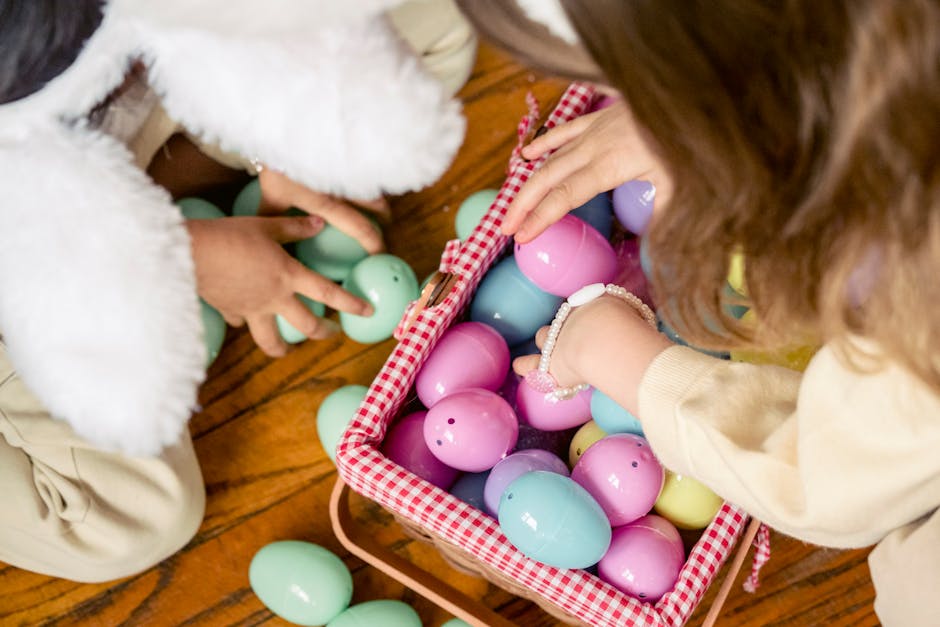Egg Memory Game
Write down pairs of items related to the Easter story on small paper slips, such as a cross and an empty tomb. Place each pair into its own set of plastic eggs, using at least 12 eggs in total.
Choose a spacious playing area, either indoors or outdoors, and scatter the eggs within defined boundaries.
Divide the children into small teams or pairs to encourage interaction and teamwork. Explain the rules: each team must find and match the pairs related to the Easter story, and share what each pair represents.
Set a timer for 10-15 minutes to create a sense of excitement. The team that matches the most pairs within the time limit wins a simple prize, like a colorful sticker or bookmark.
After the game, gather everyone to discuss the meaning behind the Easter symbols they found and delve deeper into the Easter story. By connecting engaging activities with foundational teachings, children can grasp the significance of Easter in a meaningful way.
Clear instructions and enthusiasm are essential to keep the children engaged. With these steps, you can create an exciting memory game with an Easter theme for your church's children's ministry.

Capture the Egg
Energize your church's youth group this Easter by transforming classic outdoor games into Easter-themed challenges. Customize Capture the Flag, now aptly renamed "Capture the Egg," for a fun adventure that reflects on the Easter narrative.
Use a large, decorated Easter egg, such as a brightly painted beach ball, as the coveted item. Divide your playing area into two territories, marking them with smaller plastic Easter eggs or colorful chalk lines with Easter motifs.
Form two teams with Easter-inspired names like "Spring Bunnies" and "Glorious Gardens." Each team defends its egg while attempting to capture the opponent's egg and return to home territory without being tagged. Add a twist by giving each participant a spoon to balance the egg on while in enemy territory.
Incorporate Easter storytelling by assigning character roles from the Resurrection story to each participant, such as the "gardener" (John 20:15), adding meaning and context to the game.
Conclude by gathering everyone for a light-hearted yet reflective chat. Discuss the values of teamwork, strategy, and perseverance highlighted during the game, drawing parallels to the Easter story. Encourage sharing thoughts on how the game's elements could symbolize different aspects of Easter.
This Easter-themed "Capture the Egg" game promises an afternoon of laughter and energetic play while weaving in the message of Easter, creating a moment of community and reflection.

Photo by kellysikkema on Unsplash
Jesus Detectives
Immerse children in the heart of Easter with an interactive storytelling session where each child embodies a character from the biblical tale. Use simple costumes like robes and headpieces made from sheets and towels to assign roles such as Mary Magdalene, the disciples, and Jesus. This approach allows children to experience the story firsthand, fostering a deeper connection and understanding.
Transform your space into scenes from the Easter story, staging areas to represent the Garden of Gethsemane, the Empty Tomb, and Calvary's hill. As children move through the scenes, they collect themed tokens—silver coins for Judas' betrayal, stone pebbles for the rolled-away tombstone, and cross-shaped crafts for Calvary. This tangible journey aids in visual and physical retention of the events.
Incorporate a "Build the Scene" craft project, providing materials for children to construct 3D models of key events like the Last Supper, the Garden of Gethsemane, and the Empty Tomb. These hands-on activities spark creativity and open doors for discussing the significance of these moments.
Host an Easter-themed puppet show where children create their own puppets to retell the story. Offer materials like socks, felt, and shadow puppets for a variety of styles. Script out key parts of the Easter narrative for children to perform.
Conclude with a peaceful reflection time, guiding children in a quiet meditation on what they've learned. Encourage them to consider what Easter means to them personally and how they can live out its messages of forgiveness, renewal, and love. Light a candle and share prayers or thoughts in this meaningful wrap-up.
By engaging both heart and hands, children delve deeper into the Easter story, learning in ways that words alone cannot teach.

Egg Shell Towers
Introduce an Easter-themed building challenge that calls for creativity and a touch of engineering. The goal is to create the tallest, most stable structure using only jelly beans and toothpicks. This activity is perfect for family gatherings or a fun afternoon with friends.
Provide a generous supply of jelly beans and toothpicks, keeping the sizes standard for fairness. Designate a clear tablespace as the construction zone to prevent mishaps and showcase the masterpieces.
Split everyone into teams of partners or small groups to encourage collaboration and brainstorming. Each team gets an equal amount of building materials. Remind everyone of the ground rules:
- Structures can only be built using jelly beans and toothpicks
- No other supports allowed
Set a timer for 10-20 minutes, depending on the ages and attention spans of your builders. As the countdown begins, watch as creativity unfolds, with teams discussing weight distribution, color patterns, and structural integrity.
At the end of the timer, measure each creation from base to the highest point to determine the tallest structure. Award bonus points for:
- Creativity
- Innovative design
- Easter-themed elements
This Jelly Bean Structure Challenge blends play with a sprinkle of learning, fostering teamwork while celebrating the season's joy. Participants engage in hands-on fun, creating sweet sculptures and memories of teamwork and laughter.

These Easter-themed activities create spaces for learning, reflection, and joyous engagement. By incorporating elements of the Easter story into interactive experiences, children and young people gain a deeper understanding of this pivotal occasion. The games and crafts celebrate the spirit of Easter while fostering connections among participants, leaving them with lasting memories of creativity and shared discovery.
Research has shown that interactive, hands-on activities are highly effective in engaging children and promoting learning1. Incorporating elements of play and creativity into religious education can help children form positive associations with their faith and develop a deeper understanding of its teachings2.
Furthermore, these activities provide opportunities for social interaction and bonding among participants, which is crucial for building a sense of community within the church3. By engaging in shared experiences and working together towards a common goal, children and young people form meaningful connections with their peers and develop a stronger sense of belonging within their faith community.
In conclusion, these Easter-themed activities offer an effective way to bring the message of Easter to life for children and young people, fostering a deeper understanding and appreciation of this important Christian celebration.
- Hirsh-Pasek K, Golinkoff RM, Berk LE, Singer DG. A Mandate for Playful Learning in Preschool: Presenting the Evidence. Oxford University Press; 2009.
- Berryman JW. Godly Play: An Imaginative Approach to Religious Education. Augsburg Fortress Publishers; 1995.
- Roehlkepartain EC, Ebstyne King P, Wagener L, Benson PL. The Handbook of Spiritual Development in Childhood and Adolescence. SAGE Publications; 2005.
Get top-notch content with Writio, the AI writer for publishers. This article was crafted by Writio.
Leave a Reply